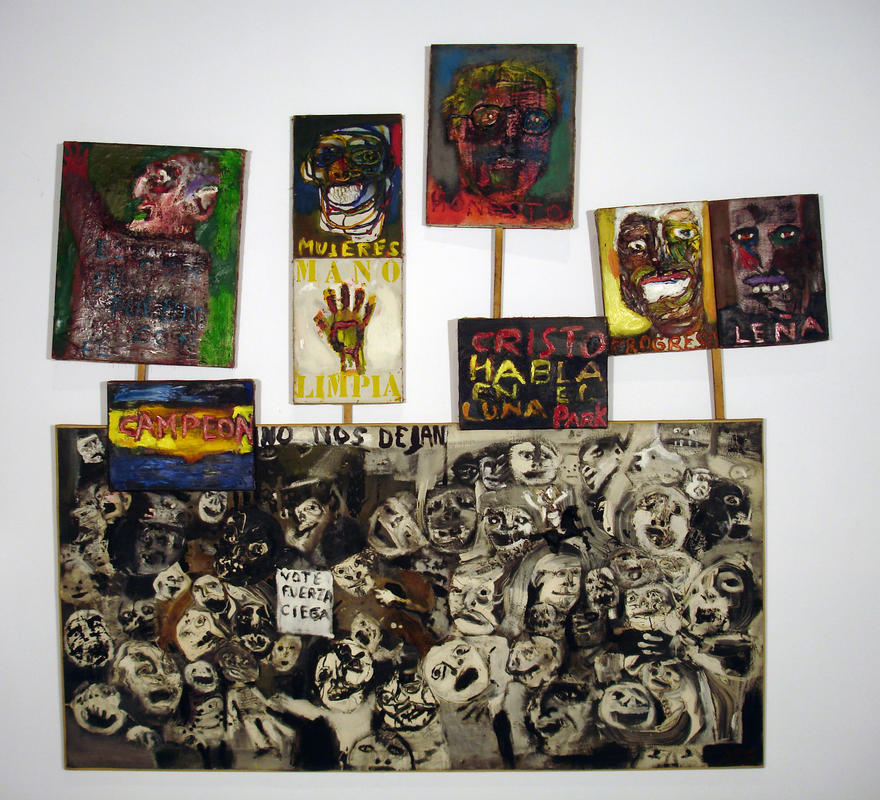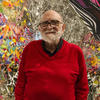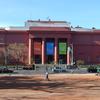More about Introduction to Hope

Contributor
Directly above the grey, clamoring masses in Introduction to Hope, Luis Felipe Noé reproduces a slogan that he saw a couple of years earlier, working as a reporter: "CRISTO HABLA EN EL LUNA PARK," (CHRIST SPEAKS IN LUNA PARK) the large Buenos Aires arena that has hosted lots of artists, from Patti Smith to Santana.
We might as well assume that this ad was speaking metaphorically, but when they did not see the stadium filled with divine light, a few people must have wanted a refund. Luna Park is also the spot where the politician Juan Perón met Eva Duarte, the woman who would become his super-famous second wife, eventually portrayed by Madonna. After Eva and Juan's deaths, Juan's third wife would take up her husband's position, becoming the first woman to hold the title of "President."
While you can try to diagnose Noé's fragmented style from the influence of de Kooning, Bacon, or Pollock, the closest links seem to be those which came after him, such as Basquiat. Even more, his terrified human images evoke the art of Stephen Gammell, the illustrator of the Scary Stories to Tell in the Dark series, true nightmare fuel. Whereas Gammell's images show isolated monsters, Noé's terrors are connected to the political situation in Argentina, especially the rallies of the Peronists, which he called "the most impressive aesthetic phenomenon I have seen in my life." Of course, "impressive," is not at all the same as "good." You would have to study Argentine politics in order to fit Perón into a political category: political writers describe his ideology as "right-wing socialism." To many U.S. readers, the term is no less of a head-scratcher than "left-wing fascism," "kosher pork cracklins" or "vegan slaughterhouse," but it is part of the popular platform of Peronism. Some people say Perȯn was a fascist, and his admiration for Mussolini is definitely weird. However, he also had a whole bunch of connections to leftists, through his pro-labor reforms. He shut down opposition journalists, like Noé's employer, the La Prensa newspaper. One of his favorite pastimes, sadly, was sheltering famous German and Croatian war criminals, although he also welcomed Jewish immigrants. He was, like Noé, full of contradictions, and knew how to cover all his bases, until his own mob turned on him and kicked him out of office.
A year after the Christ rally, Noé witnessed the coup d'etat that removed the government of Arturo Frondizi. In an interview, he makes fun of theorists who say "Ah, yes! Introduction to Hope is influenced by Christ's Entry into Brussels by James Ensor"—in fact, Noé says, nothing inspires him more than the brutal speed of change in the world. For a divided world, he made "divided pictures," like Introduction to Hope. The small frames above the lower part of Introduction to Hope mimic the signs in the hands of the demonstrators. One of the signs says "vote for blind force," always a popular political position.
Sources
- Giunta, Andrea. Listen, Here, Now!: Argentine Art of the 1960s : Writings of the Avant-garde. New York: The Museum of Modern Art, 2004.
- Giunta, Andrea. Vanguardia, internacionalismo y política: arte argentino en los años sesenta. Buenos Aires: Siglo veintiuno, 2008.
- "Introducción a la esperanza." Museos Vivos, http://museosvivos.educ.ar/index994c.html?p=1104.
- "Introducción a la esperanza, 1963." Fundaciȯn Konex, https://www.fundacionkonex.org/obra-obras-maestras-66-introduccion-a-la….
- Orfano, Belén Papa. "'El Caos' de Luis Felipe Noé en el Bellas Artes." El Cronista Clase, Jul. 22, 2017, https://www.cronista.com/clase/checklist/El-caos-de-Luis-Felipe-Noe-en-….
- Studi latinoamericani, Volume 1. Centro internazionale alti studi latinoamericani, Università di Udine. Dipartimento di storia e tutela dei beni culturali: 2005.
- Yaccar, María Daniela. "LUIS FELIPE NOÉ EXPONE LAS MONUMENTALES NOS ESTAMOS ENTENDIENDO Y LA ESTÁTICA VELOCIDAD EN EL MUSEO NACIONAL DE BELLAS ARTES." Página 12, Jan. 3, 2010, https://www.pagina12.com.ar/diario/suplementos/espectaculos/6-16535-201….











